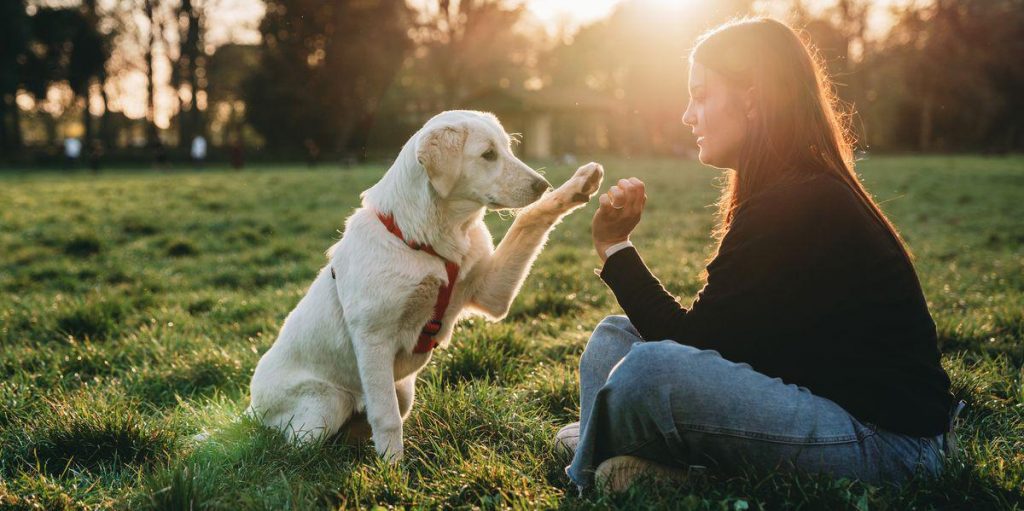Every dog lover is always eager to pet a dog. But have you ever given thought to how to pet a dog the correct way? You might not have. We don’t bother much thinking about it. We see a puppy, run towards it, and start petting it. Thankfully, we get some tail waggles in return.
But it’s not the case with every dog. No doubt dogs love being petted, but not every dog enjoys similar types of pets, and you might need to learn how to pet a dog in the right way. Why? Because the way you pet a dog can determine your relations with them. So, if you want to build a strong bond with the canine, you must read this guide.
Dog’s Permission is Necessary
Rushing over to a stranger’s dog will undoubtedly scare them. If the dog has an owner, ask their permission first. Once the dog’s pet parent has given permission, approach cautiously and from the side rather than directly. Keep an eye on the dog as you approach.

To handle larger dogs, stand with your body facing the side; to handle smaller dogs, kneel facing the side. It’s not required to put out your hand because a dog can learn much about you even from a distance. Instead, wait for the dog to come over to smell you. The dog is not interested in interacting with you if the dog chooses to remain distant.
If the dog approaches you, pet his shoulders for three seconds before ceasing. You can continue if he demands more, such as pawing at you or getting closer. This is how to pet a dog you’re unfamiliar with.
Being Gentle is the Key
Although it should go without saying that no one should ever be rough with a dog, being extra gentle can help the dog feel more at peace. Additionally, it can make petting less disruptive.
When petting, be gentle and slow, and stroke in the direction that the fur grows. If you don’t know the dog and don’t see how he likes to play, go smooth and smooth.
Petting should be soothing and comforting for both the dog and the person who benefits from the shared contact. “A dog is likely to lean in close for more petting if you pet him in a relaxed, leisurely, and loving manner.”
Observe How the Dog is Feeling
Dogs are excellent at expressing their emotions through body language. A dog is probably having fun when you are caressing him if he leans into you and his tail is loosely wagging. He’s telling you he’s stressed if he’s yawning, licking his lips, looking away, or pulling his ears back. If a dog exhibits any stress symptoms, stop touching him and move back.
If he comes towards you and sniffs you, you can offer a hand and start again. Giving them their personal space can help you gain their trust, and that’s how to pet a dog that might be feeling stressed.
You can strengthen your bond with your dog and create a more satisfying relationship by paying attention to how he responds to physical contact and taking his lead.
Avoid Sudden Hugs
It can be tempting to hug the dog when he becomes comfortable with you, and that’s how we frequently express our love and affection. Although most dogs dislike hugs, people enjoy giving and receiving them.
You likely know how your own dog reacts to hugs, but it’s never a smart idea to test another dog’s tolerance for a hug. It’s a dangerous concept. Instead, find an area where the dog seems to enjoy pets and softly brush the dog. If the dog tries to climb on you, you might consider holding them gently. But a sudden initiative to hug isn’t advised.
When Not to Pet the Dog
If a dog exhibits signs of fear or aggression, do not pet it. When they wish to be left alone, dogs will growl, bark, snarl, or flash their teeth. Pinning their ears back, licking their lips, or putting their tails between their knees are all indications of nervousness.
Avoid making fast movements and pay attention to any changes in the dog’s behaviour. If the dog reacts scared or violently when you make touch, step back because this is not how to pet a dog.
Keep your fingers away from the mouth or face of a dog that is aggressive. If the dog wags its tail or licks your hand, it’s an indication they’re having fun, but if you decide to make physical contact with them, keep an eye on its behaviour.
Want to Learn More About Dogs?
Dogs lovers are always eager to learn more about their favourite animals, and Helping Fido sustains to assist such people. We offer advice and guidance to help you build strong relationships with your dogs. Our professionals work to provide you with information about dog nutrition, health, behaviour, and many more. Visit our website to learn how you can raise a dog with love and comfort.
Author Bio:-
Charles Costa is the owner of Helping Fido working to guide dog parents on how to build strong connections with their pets. I love writing about dogs and am willing to help you raise your pets effortlessly. I provide information on various dog-related issues such as their behaviour, nutrient needs, and many more.
Article Supplied
